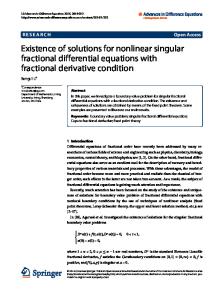Solution Strategies for Nonlinear Equations and Computation of Singular Points
Investigation of nonlinear static and dynamic response of solids and structures requires knowledge about the stability behaviour. In general we have to detect singular points (e.g. limit or bifurcation points) or the global loss of stability and furthermo
- PDF / 3,381,276 Bytes
- 41 Pages / 481.89 x 691.654 pts Page_size
- 64 Downloads / 367 Views
P. Wriggers T.H. Darmstadt, Darmstadt, Germany
A. N. Kounadis et al. (eds.), Nonlinear Stability of Structures © Springer-Verlag Wien 1995
272
P. Wriggers
2.1 Introduction Investigation of nonlinear static and dynamic response of solids and structures requires knowledge about the stability behaviour. In general we have to detect singular points (e.g. limit or bifurcation points) or the global loss of stability and furthermore one has to be able to follow nonlinear solution paths. In the finite element literature mostly the so called arc-length procedures are applied to follow nonlinear solutions paths, see e.g. Rib (1972), Crisfield (1981 ), Ramm (1981). These methods work well for static applications and are useful to investigate global solutions of nonlinear problems. In case of dynamic problems time stepping procedures have to be applied to solve the nonlinear response of a structure. Different possibilities exist for the computation of singular points on the load deflection curve in the case of static responses. Simple methods for this purpose are given by inspection of the determinant of the tangent stiffness matrix or the calculation of the current stiffness parameter, Bergan et. al. (1988). These methods do not provide a tool to calculate stability points accurately since the basis of path-following is an incremental procedure. If a stability point has to be computed within a certain accuracy a bi-section method for the determinant of the Hessian is a simple but sometimes slow approach, see e.g. Decker, Keller (1980), Wagner, Wriggers (1988). A more efficient approach is provided by a Newton-type method for the direct calculation of stability points. The basis for this procedure is an extension of the nonlinear set of equations by a constraint condition which introduces additional information about the stability points. Here different possibilities exist, see e.g. the overview article of Mittelmann, Weber (1980). Such so called extended systems open the possibility to compute limit or bifurcation points directly. These techniques lead with a consistent linearization of the extended system to a Newton scheme with quadratical convergence behaviour, see Moore, Spence (1980). Furthermore, the extended system provides enough information to distinguish between limit and bifurcation points. For a finite element implementation of this method, see Wriggers, Wagner, Miehe (1988) and Wriggers, Simo (1990). Once a stability point has been detected one has to decide whether the primary or secondary branch of the global solution curve should be followed. In case of a limit point there exists only a primary branch which can be calculated using a pathfollowing method. If, in a bifurcation point, the investigation of the secondary branch is necessary a branch-switching procedure has to be employed. In many engineering applications buckling mode injection which is equivalent to the superposition of buckling modes onto the displacement field at the bifurcation point is used to arrive at the
273
Solution Strategies for
Data Loading...











